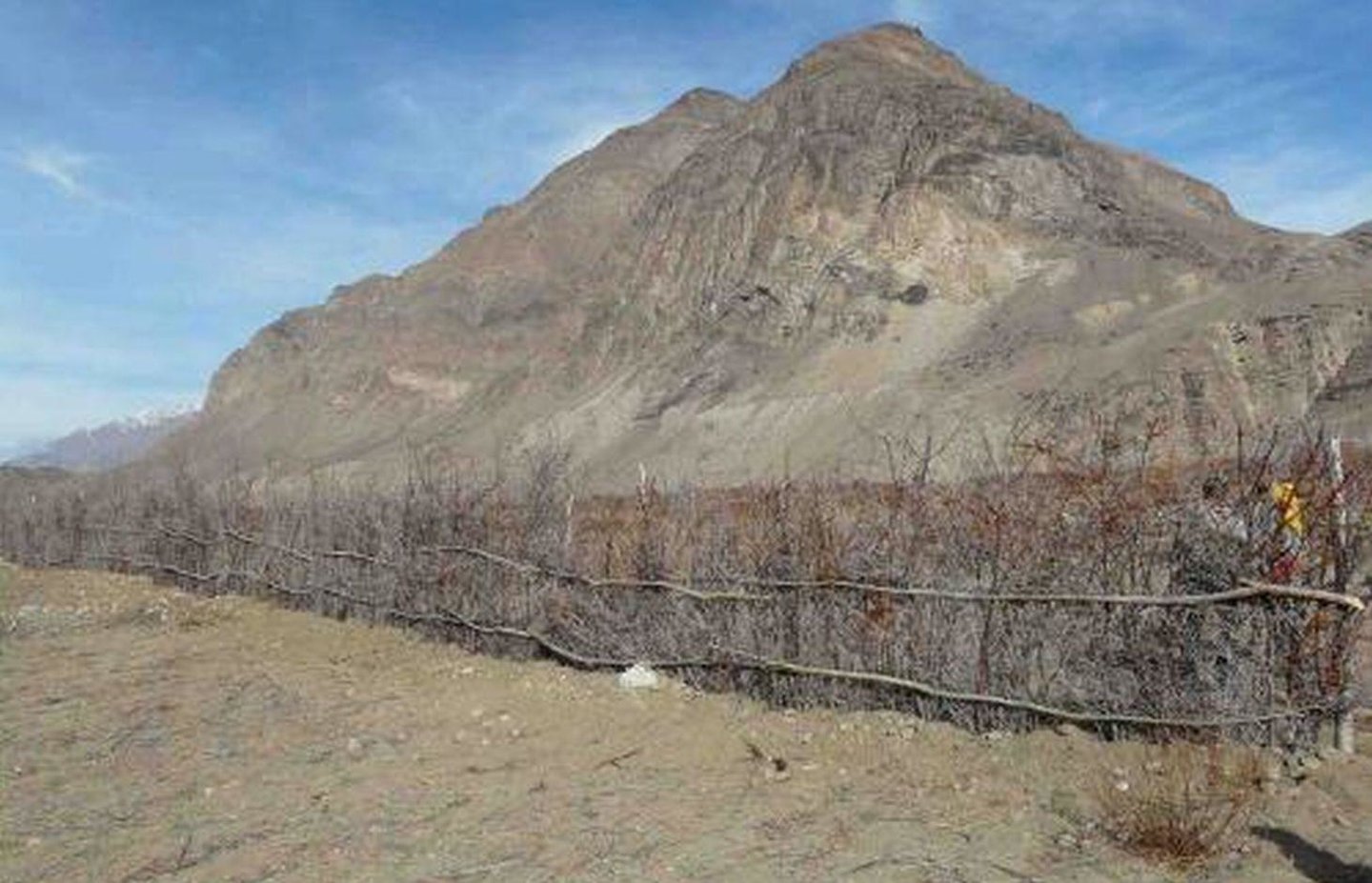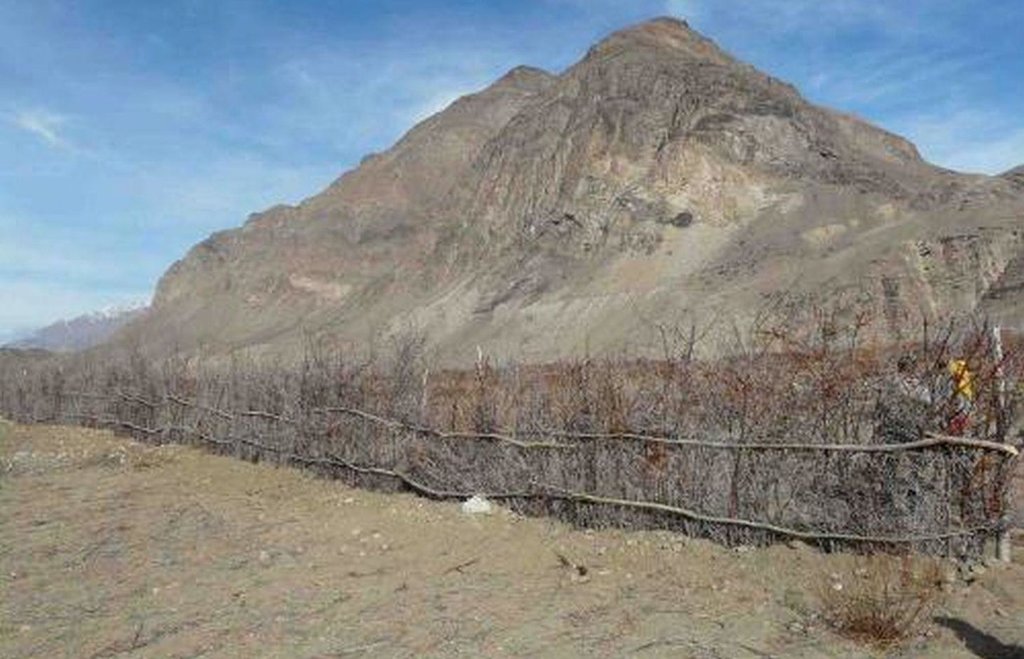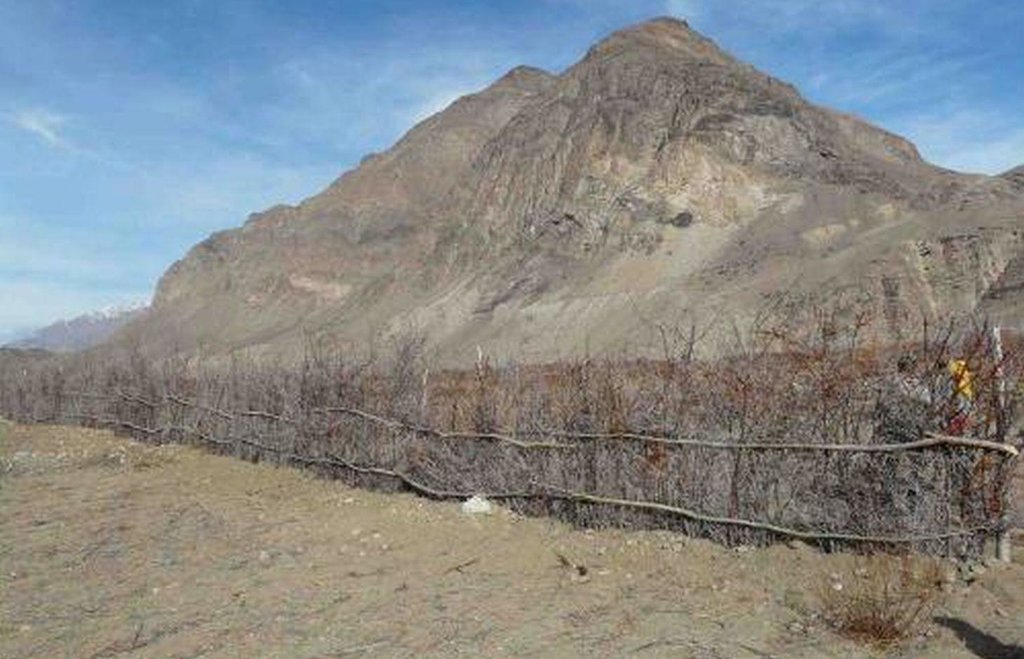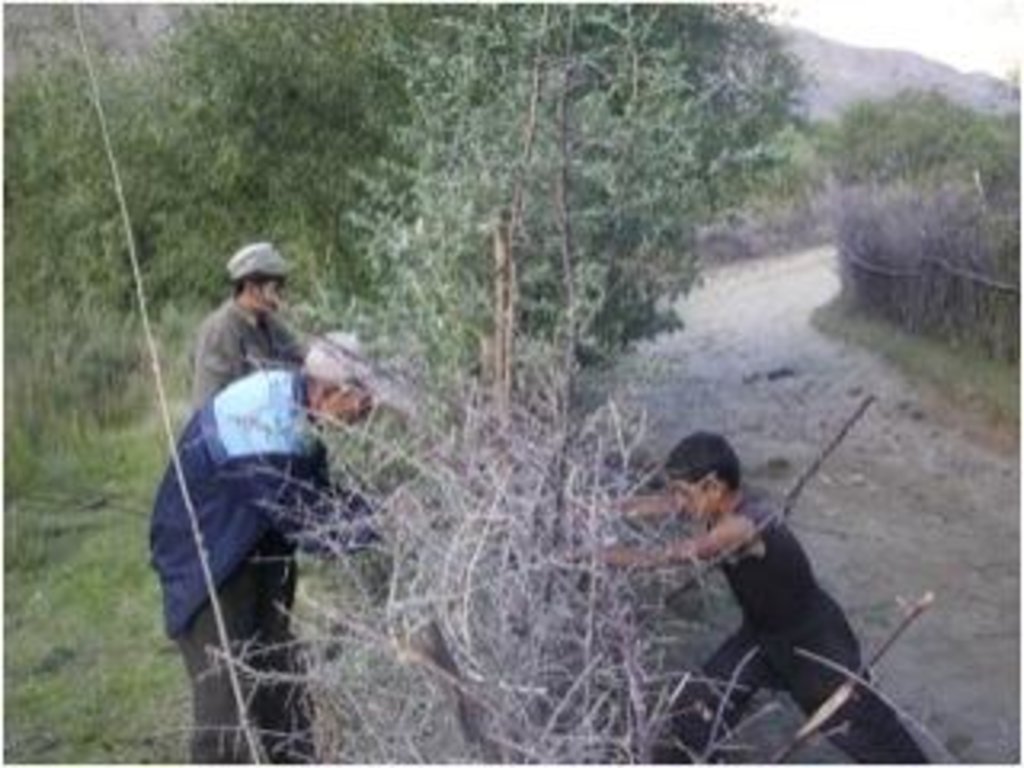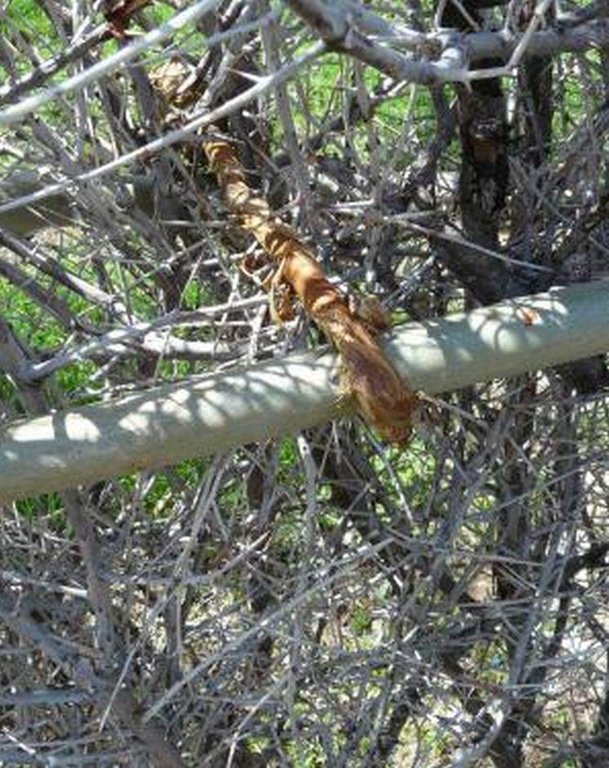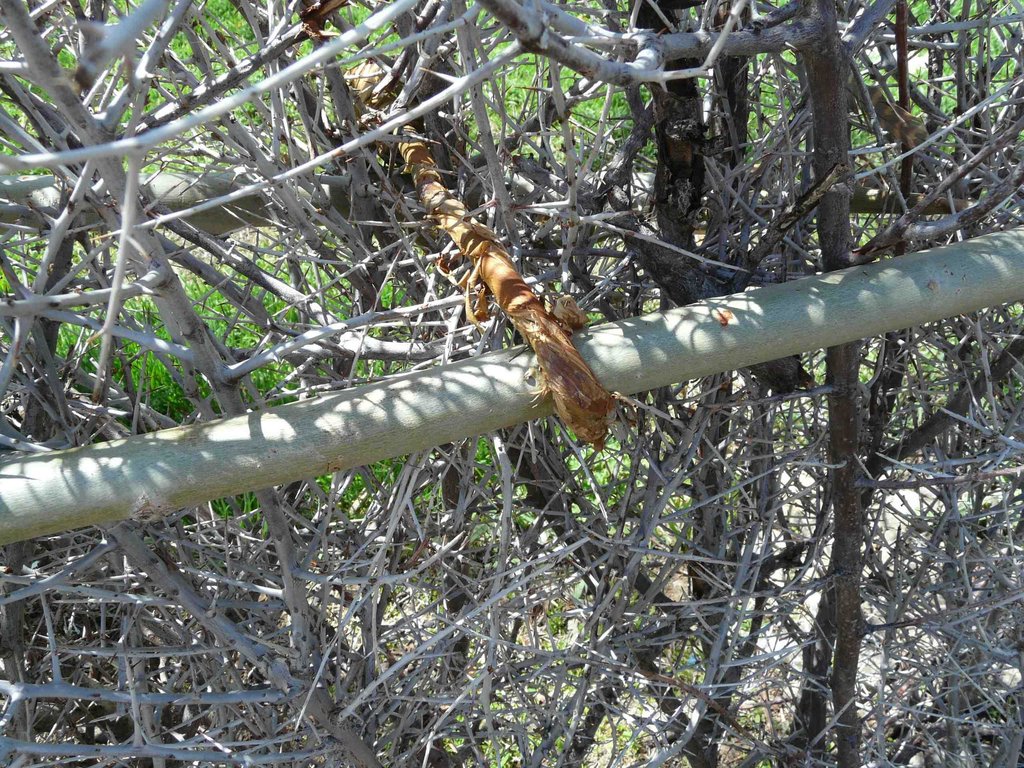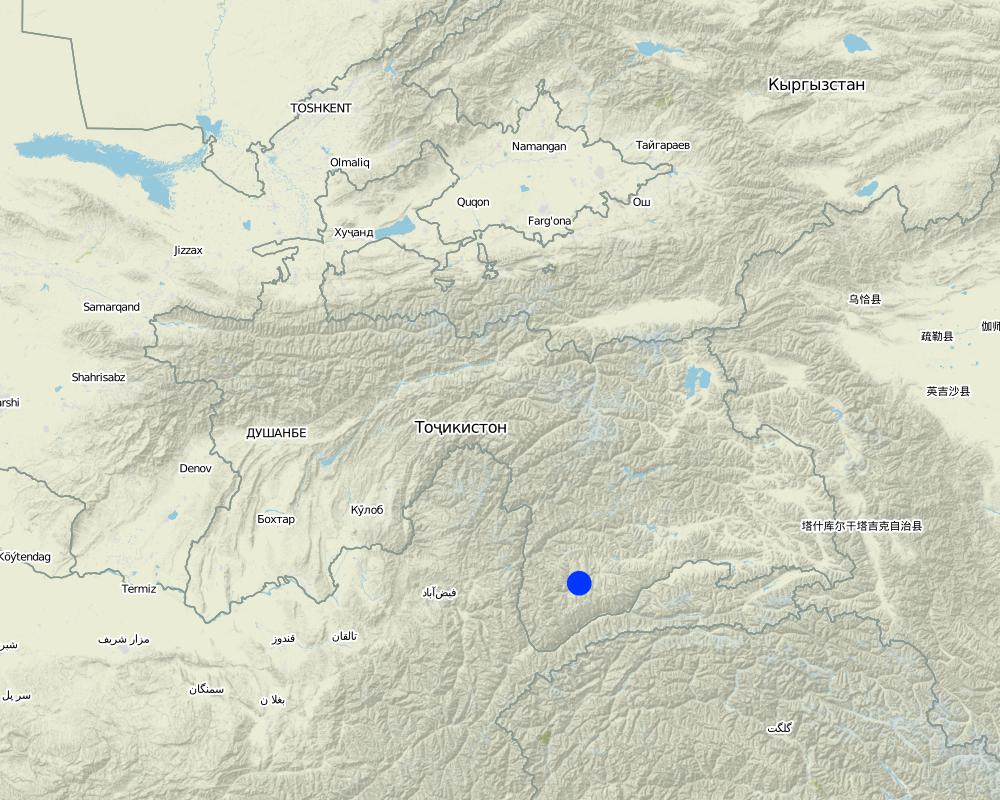Establishment of living seabuckthorn fences for the protection of reforestation sites (CACILM) [Tajiquistão]
- Criação:
- Atualização:
- Compilador/a: Roziya Kirgizbekova
- Editor: –
- Revisores: Fabian Ottiger, Alexandra Gavilano
technologies_1036 - Tajiquistão
- Resumo completo em PDF
- Resumo completo em PDF para impressão
- Resumo completo no navegador
- Resumo completo (sem formatação)
- Establishment of living seabuckthorn fences for the protection of reforestation sites (CACILM): 27 de Dezembro de 2016 (inactive)
- Establishment of living seabuckthorn fences for the protection of reforestation sites (CACILM): 2 de Junho de 2017 (inactive)
- Establishment of living seabuckthorn fences for the protection of reforestation sites (CACILM): 22 de Julho de 2017 (inactive)
- Establishment of living seabuckthorn fences for the protection of reforestation sites (CACILM): 14 de Agosto de 2019 (public)
Veja as seções
Expandir tudo Recolher tudo1. Informação geral
1.2 Detalhes do contato das pessoas capacitadas e instituições envolvidas na avaliação e documentação da tecnologia
Pessoa(s) capacitada(s)
Especialista em GST:
Angermann Michael
Deutsche Gesellschaft für Internationale Zusammenarbeit (GIZ) GmbH,
Tajiquistão
Especialista em GST:
Neusel Benjamin
Deutsche Gesellschaft für Internationale Zusammenarbeit (GIZ) GmbH,
Tajiquistão
Especialista em GST:
Kirchhoff Joachim F.
GIZ GmbH,
Nome do projeto que facilitou a documentação/avaliação da Tecnologia (se relevante)
Central Asian Countries Initiative for Land Management (CACILM I)Nome da(s) instituição(ões) que facilitou(ram) a documentação/ avaliação da Tecnologia (se relevante)
Deutsche Gesellschaft für Internationale Zusammenarbeit (GIZ) - Alemanha1.3 Condições em relação ao uso da informação documentada através de WOCAT
O compilador e a(s) pessoa(s) capacitada(s) aceitam as condições relativas ao uso de dados documentados através do WOCAT:
Sim
1.5 Referência ao(s) questionário(s) sobre abordagens GST (documentado(s) usando WOCAT)
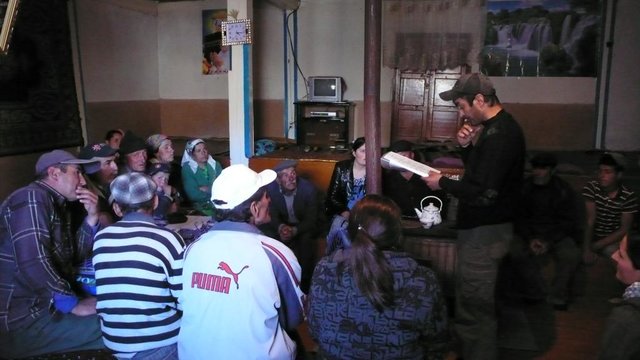
Savings Book Approach [Tajiquistão]
Reforestation of deserted state forest plots through a financial incentive system for the labour intensive first years of forest establishment, after which harvests of forest products from the plot provide income opportunities for the forest tenants and the State Forestry Agency (in the frame of CACILM).
- Compilador/a: Roziya Kirgizbekova
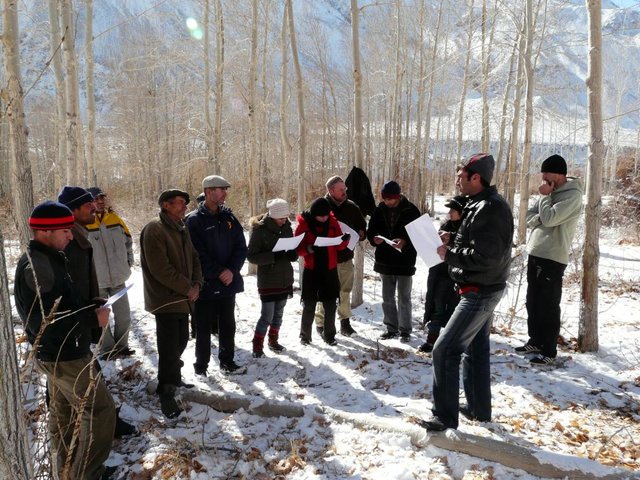
Joint Forest Management (JFM) [Tajiquistão]
Protection and rehabilitation of state forests based on joint long term agreements set up between the State Forestry Agency, and local forest users (in the frame of CACILM).
- Compilador/a: Roziya Kirgizbekova
2. Descrição da tecnologia de GST
2.1 Descrição curta da tecnologia
Definição da tecnologia:
Protection of reforestation sites (willow, poplar and fruit trees) through living seabuckthorn perimeter fencing on Joint Forestry Management plots.
2.2 Descrição detalhada da tecnologia
Descrição:
In the heavily degraded flood plain forests of the Pamirs in eastern Tajikistan, living fences made out of seabuckthorn are protecting reforestation and Joint Forestry Management (JFM) sites. A living seabuckthorn fence consists of two layers. The outer layer is an instant fence made of thorny seabuсkthorn branches. The purpose of the outer layer is to immediately restrict animal and human access to the reafforestation site. The outer layer also buffers the inner layer of seabuckthorn, which is planted from seabuckthorn seedlings. The inner layer will establish itself over a number of seasons, eventually growing to a height of 1.5-2m. Once established, the seabuckthorn bush provides a low cost sustainable perimeter fence to protect reforestation activities. The bush also produces fruits for processing (in the frame of CACILM)
Purpose of the Technology: The purpose of this technology is to improve heavily degraded forest areas and establish new areas by restricting open access to the human population and preventing uncontrolled livestock grazing. As part of the Joint Forestry Management approach, these reforested areas are leased to the land user providing long-term legal control, as well as income opportunities for the tenants and the State Forestry Agency.
Establishment / maintenance activities and inputs: As part of the Joint Forestry Management approach (TAJ015), land is allocated by the State Forestry Agency to a designated land user. Once the size of the plot is established, a solid fence constructed of off-cuts of seabuckthorn and supported by willow poles is established around the perimeter of the JFM reforestation area. The seabuckthorn branches are fixed together with willow twigs, willow branches or wire and are attached to wooden poles. Once completed, seabuckthorn seedlings are planted at 0.5m intervals along a small irrigation channel on the inner side of the perimeter fence. After a few seasons these seedlings will grow into a natural living fence, which will take over the protection role from the perimeter fence constructed from off-cuts. The reforestion area is planted with branches of willow and poplar and interspersed with fruit trees. Reforestation planting materials are readily available in most parts of GBAO, and the Forestry Agency facilitates free access to seabuckthorn branches, willow branches and wooden poles. If required, wire and tools are provided by the JFM project.
Natural / human environment: The natural forest cover and biological diversity in many areas of GBAO has been significantly degraded. While population density in GBAO is low, natural resources are scarce due to the high altitude mountain environment and the pressure on these resources is great. In Soviet times, the Pamir region was highly dependent on subsidized coal from other parts of the Soviet Union. After independence, coal was no longer available and other fuel had to be sourced. Population pressure, poverty, and the lack of established local level institutions to manage forest lands have rendered forest areas an open access resource where the local population harvests forest products and grazes livestock without regulation. The local Forestry Agencies do not have the capacity to control overuse or to implement sustainable forestry management. As a part of the Joint Forestry Management approach (TAJ015) this SLM technology is a reintroduction of a traditional method for the protection of reforestation sites against livestock and, additionally, it clearly demarcates forest plot ownership and boundaries.
2.3 Fotos da tecnologia
2.5 País/região/locais onde a tecnologia foi aplicada e que estão cobertos nesta avaliação
País:
Tajiquistão
Região/Estado/Província:
Tajikistan, Gorno Badakhshan Autonomous Region (GBAO)
Especificação adicional de localização:
Ishkashim, Roshtkala and Shugnan Districts
Comentários:
Total area covered by the SLM Technology is 20 km2.
Map
×2.6 Data da implementação
Caso o ano exato seja desconhecido, indique a data aproximada:
- menos de 10 anos atrás (recentemente)
2.7 Introdução da tecnologia
Especifique como a tecnologia foi introduzida:
- através de projetos/intervenções externas
Comentários (tipos de projeto, etc.):
Living seabuckthorn fencing is a traditional/indigenous method used for many years in the Pamirs. This technology has more recently been promoted by the project for the protection of forest plots under JFM. Similarly, the tree planting techniques used also follow traditionally applied methods in the Pamirs.
3. Classificação da tecnologia de GST
3.2 Tipo(s) atualizado(s) de uso da terra onde a tecnologia foi aplicada

Floresta/bosques
- plantation forestry
- Seabuckthorn
Produtos e serviços:
- Madeira
- Lenha
- Frutas e nozes
- Outros produtos florestais
- Conservação/proteção da natureza
- Proteção contra desastres naturais
Comentários:
Major land use problems (compiler’s opinion): Open access to forests leads to illegal use and destruction of forests; grazing of livestock within forest areas hinder regeneration of forests.
Major land use problems (land users’ perception): Shortage of fuel wood for cooking and heating; lack of pastures and fodder for maintaining or increasing livestock herds; land degradation and increasing vulnerability to natural hazard periods
Selective felling of (semi-) natural forests: Yes
Plantation forestry: Yes
Problems / comments regarding forest use: For now most of the forest plots are strongly degraded natural and formerly forested areas. So far felling is strongly restricted and permitted only where afforestation is conducted.
Forest products and services: timber, fuelwood, fruits and nuts, other forest products / uses (honey, medical, etc.), nature conservation / protection, protection against natural hazards
Future (final) land use (after implementation of SLM Technology): Forests / woodlands: Fp: Plantations, afforestations
3.3 O uso do solo mudou devido à implementação da Tecnologia?
O uso do solo mudou devido à implementação da Tecnologia?
- Sim (Por favor, preencha as perguntas abaixo com relação ao uso do solo antes da implementação da Tecnologia)
Uso do solo misturado dentro da mesma unidade de terra:
Sim
Especificar o uso misto da terra (culturas/ pastoreio/ árvores):
- Silvipecuária

Floresta/bosques
- Plantação de árvores, reflorestamento
3.6 Medidas de GST contendo a tecnologia

Medidas vegetativas
- V1: cobertura de árvores/arbustos

Medidas de gestão
- M5: Controle/mudança de composição de espécies
Comentários:
Main measures: vegetative measures
Secondary measures: management measures
Type of vegetative measures: aligned: -along boundary
3.7 Principais tipos de degradação da terra abordados pela tecnologia

Erosão do solo pelo vento
- Et: Perda do solo superficial
- Eo: efeitos de degradação externa

Degradação biológica
- Bc: redução da cobertura vegetal
- Bh: perda dos habitats
Comentários:
Main causes of degradation: deforestation / removal of natural vegetation (incl. forest fires), over-exploitation of vegetation for domestic use, land tenure, governance / institutional (Lack of human and material resources of Forest Agency)
Secondary causes of degradation: overgrazing, population pressure, poverty / wealth, war and conflicts (Lack of energy resources during civil war)
3.8 Redução, prevenção ou recuperação da degradação do solo
Comentários:
Main goals: rehabilitation / reclamation of denuded land
Secondary goals: prevention of land degradation, mitigation / reduction of land degradation
4. Especificações técnicas, implementação de atividades, entradas e custos
4.1 Desenho técnico da tecnologia
Especificações técnicas (relacionada ao desenho técnico):
Living seabuckthorn fence: The dead part of the fence prevents livestock from entering the forest plot, while in the long run the planted seedlings take over this role by forming a dense living seabuckthorn barrier.
Location: -. Gorno Badakhshan, Tajikistan
Date: February 2011
Technical knowledge required for field staff / advisors: low
Technical knowledge required for land users: moderate (It is not a difficult technology to implement.)
Main technical functions: improvement of ground cover, stabilisation of soil (eg by tree roots against land slides), increase of biomass (quantity)
Secondary technical functions: increase / maintain water stored in soil, water harvesting / increase water supply, water spreading, reduction in wind speed, promotion of vegetation species and varieties (quality, eg palatable fodder)
Aligned: -along boundary
Vegetative material: T : trees / shrubs
Number of plants per (ha): 400-800
Vertical interval within rows / strips / blocks (m): 0.5
Trees/ shrubs species: seabuckthorn (Hippophae rhamnoides)
Change of land use type: Enclosure of the plot, change from grazing to forest
Change of land use practices / intensity level: Change from open access to controlled access (fence)
Control / change of species composition
Autor:
Hahnewald/Gaude/Rosset
4.2 Informação geral em relação ao cálculo de entradas e custos
Outro/moeda nacional (especifique):
Tajik Somoni
Se for relevante, indique a taxa de câmbio do USD para moeda local (por exemplo, 1 USD = 79,9 Real): 1 USD =:
4,5
Indique a média salarial da mão-de-obra contratada por dia:
7.00
4.3 Atividades de implantação
| Atividade | Periodicidade (estação do ano) | |
|---|---|---|
| 1. | Establishment of living seabuckthorn fence | Any time |
| 2. | Planting of poplar and willows | early spring |
| 3. | Planting of fruit trees | early spring |
4.4 Custos e entradas necessárias para a implantação
| Especifique a entrada | Unidade | Quantidade | Custos por unidade | Custos totais por entrada | % dos custos arcados pelos usuários da terra | |
|---|---|---|---|---|---|---|
| Mão-de-obra | Establishment of living seabuckthorn fence | Mandays | 160,0 | 6,6625 | 1066,0 | 100,0 |
| Mão-de-obra | Planting of poplar and willows | Mandays | 40,0 | 6,65 | 266,0 | 100,0 |
| Mão-de-obra | Planting of fruit trees | Mandays | 3,0 | 6,666 | 20,0 | 100,0 |
| Equipamento | Tools | piece | 4,0 | 5,5 | 22,0 | |
| Material vegetal | Seedlings Seabuckthorn | piece | 2000,0 | 0,2225 | 445,0 | |
| Material vegetal | Seedlings of poplar and willows | piece | 1200,0 | 0,22166 | 265,99 | |
| Material vegetal | Seedlings fruit trees | piece | 50,0 | 1,11 | 55,5 | 100,0 |
| Material de construção | Wood | 360 cub per m | 1000,0 | 0,8 | 800,0 | |
| Material de construção | Wire | m | 1000,0 | 0,111 | 111,0 | |
| Custos totais para a implantação da tecnologia | 3051,49 | |||||
| Custos totais para o estabelecimento da Tecnologia em USD | 678,11 | |||||
Comentários:
Duration of establishment phase: 1 month(s)
4.5 Atividades recorrentes/manutenção
| Atividade | Periodicidade/frequência | |
|---|---|---|
| 1. | Fence repair | spring, annually |
| 2. | Plant tending | spring, annually |
4.6 Custos e entradas necessárias pata a manutenção/atividades recorrentes (por ano)
| Especifique a entrada | Unidade | Quantidade | Custos por unidade | Custos totais por entrada | % dos custos arcados pelos usuários da terra | |
|---|---|---|---|---|---|---|
| Mão-de-obra | Fence repair | Mandays | 3,0 | 6,666 | 20,0 | 100,0 |
| Mão-de-obra | Plant tending | Mandays | 4,0 | 6,75 | 27,0 | 100,0 |
| Equipamento | Tools | piece | 2,0 | 13,5 | 27,0 | |
| Material vegetal | 8,0 | |||||
| Material de construção | Wood | 2 cub per m | 1000,0 | 0,0089 | 8,9 | 100,0 |
| Material de construção | Wire | meter | 10,0 | 0,1 | 1,0 | 100,0 |
| Custos totais para a manutenção da tecnologia | 83,9 | |||||
| Custos totais de manutenção da Tecnologia em USD | 18,64 | |||||
Comentários:
Machinery/ tools: Spades, scissors, picks, gloves, planting bars.
The costs were calculated for 1000m of live seabuckthorn fence and approximately 1ha of tree planting, including 50 fruit trees and 1200 poplars and willows. Costs were calculated in April 2011. It is assumed that seabuckthorn and wood for poles are readily available on the forest plot or can be provided by the State Forestry Agency from nearby plots. Seedlings needed for the live part of the fence are very small parts of seabuckthorn plants, which are available as well wherever seabuckthorn grows. Tools are provided through the Joint Forestry Management project for the period they are needed for construction and maintenance. The mentioned enrichment plantings do not apply to every plot to the same extent. These also highly depend on the motivation and interest of the tenant.
4.7 Fatores mais importantes que afetam os custos
Descreva os fatores mais determinantes que afetam os custos:
The seabuckthorn seedlings are readily available in the area of implementation and incur no financial cost to the forest tenant. The labour is provided by the forest tenant. Labour is potentially a major expense if the land user must pay for it. Factors that contribute to the amount of labour required include the distance the seabuckthorn wood and seedlings have to be transported and the soil texture for the digging of a trench for the erection of the fence.
So far, the material needed for fencing and tree planting has been provided free of charge by the Forestry Agency. The only financial cost to the land user is the cost of the fruit trees, approximately 5 som per sapling. The land is provided by the Forestry Agency free of charge, however percentages of harvested forest products have to be paid to the Forestry Agency as the land owner's share.
5. Ambiente natural e humano
5.1 Clima
Precipitação pluviométrica anual
- <250 mm
- 251-500 mm
- 501-750 mm
- 751-1.000 mm
- 1.001-1.500 mm
- 1.501-2.000 mm
- 2.001-3.000 mm
- 3.001-4.000 mm
- > 4.000 mm
Especificações/comentários sobre a pluviosidade:
Spring and autumn are (moderate) rainy seasons, summer is a dry period of min. 3 months
Zona agroclimática
- Árido
Thermal climate class: temperate. continental climate, cold winters but warm, rather long summers
5.2 Topografia
Declividade média:
- Plano (0-2%)
- Suave ondulado (3-5%)
- Ondulado (6-10%)
- Moderadamente ondulado (11-15%)
- Forte ondulado (16-30%)
- Montanhoso (31-60%)
- Escarpado (>60%)
Formas de relevo:
- Planalto/planície
- Cumes
- Encosta de serra
- Encosta de morro
- Sopés
- Fundos de vale
Zona de altitude:
- 0-100 m s.n.m.
- 101-500 m s.n.m.
- 501-1.000 m s.n.m.
- 1.001-1.500 m s.n.m.
- 1.501-2.000 m s.n.m.
- 2.001-2.500 m s.n.m.
- 2.501-3.000 m s.n.m.
- 3.001-4.000 m s.n.m.
- > 4.000 m s.n.m.
Indique se a tecnologia é aplicada especificamente em:
- Posições convexas
Comentários e outras especificações sobre a topografia:
Footslopes only where there is sufficient water coming from the gorges. Flood plain forests in the valley floors (convex). Flood plain forests in valley floors, flat areas.
5.3 Solos
Profundidade do solo em média:
- Muito raso (0-20 cm)
- Raso (21-50 cm)
- Moderadamente profundo (51-80 cm)
- Profundo (81-120 cm)
- Muito profundo (>120 cm)
Textura do solo (solo superficial):
- Grosso/fino (arenoso)
Matéria orgânica do solo superficial:
- Baixo (<1%)
5.4 Disponibilidade e qualidade de água
Lençol freático:
< 5 m
Disponibilidade de água de superfície:
Médio
Qualidade da água (não tratada):
Água potável boa
A salinidade da água é um problema?
Não
5.5 Biodiversidade
Diversidade de espécies:
- Médio
5.6 Características dos usuários da terra que utilizam a tecnologia
Orientação de mercado do sistema de produção:
- Subsistência (autoabastecimento)
- misto (subsistência/comercial)
Rendimento não agrícola:
- >50% de toda renda
Nível relativo de riqueza:
- Pobre
Indivíduos ou grupos:
- Indivíduo/unidade familiar
Gênero:
- Homens
Indique outras características relevantes dos usuários da terra:
Land users applying the Technology are mainly common / average land users
Difference in the involvement of women and men: Women are encouraged to participate, but as the work consists in rather strenuous forestry work, it is mainly applied by men.
Population density: < 10 persons/km2
Annual population growth: 1% - 2%
10% of the land users are average wealthy.
80% of the land users are poor (mostly villagers with no formal employment).
10% of the land users are poor.
Off-farm income specification: Mostly subsistence farming. Income mainly from remittances and formal employment.
5.7 Área média de terrenos utilizados pelos usuários de terrenos que aplicam a Tecnologia
- < 0,5 ha
- 0,5-1 ha
- 1-2 ha
- 2-5 ha
- 5-15 ha
- 15-50 ha
- 50-100 ha
- 100-500 ha
- 500-1.000 ha
- 1.000-10.000 ha
- > 10.000 ha
É considerado pequena, média ou grande escala (referente ao contexto local)?
- Pequena escala
Comentários:
Average area of land owned or leased by land users applying the Technology: 0.5-1 ha, 1-2 ha, 2-5 ha, 5-15 ha
5.8 Propriedade de terra, direitos de uso da terra e de uso da água
Propriedade da terra:
- Estado
Direitos do uso da terra:
- Arrendado
Direitos do uso da água:
- Comunitário (organizado)
Comentários:
Forest plots of the State Forestry Agency are leased to local forest tenants according to the procedure described in the approach TAJ015 "Joint Forestry Management". Therefore the tenants hold 20-years management and user rights specified in the contract for the leased plots. The technology is applied on these forest plots leased by the State Forestry Agency. Water use rights are strictly regulated on a communal basis, whereas use rights for forest plots have to be negotiated on a communal basis as well.
5.9 Acesso a serviços e infraestrutura
Saúde:
- Pobre
- Moderado
- Bom
Educação:
- Pobre
- Moderado
- Bom
Assistência técnica:
- Pobre
- Moderado
- Bom
Emprego (p. ex. não agrícola):
- Pobre
- Moderado
- Bom
Mercados:
- Pobre
- Moderado
- Bom
Energia:
- Pobre
- Moderado
- Bom
Vias e transporte:
- Pobre
- Moderado
- Bom
Água potável e saneamento:
- Pobre
- Moderado
- Bom
Serviços financeiros:
- Pobre
- Moderado
- Bom
6. Impactos e declarações finais
6.1 Impactos no local mostrados pela tecnologia
Impactos socioeconômicos
Produção
Produção de forragens
Produção de madeira
Quantidade posterior à GST:
2-10m3
Comentários/especificar:
Before: illegal open access
Diversidade de produtos
Comentários/especificar:
non-timber forest products
Geração de energia
Disponibilidade e qualidade de água
Disponibilidade de água para irrigação
Renda e custos
Diversidade de fontes de rendimento
Impactos socioculturais
Segurança alimentar/auto-suficiência
Estado de saúde
Conhecimento de GST/ degradação da terra
Situação de grupos social e economicamente desfavorecidos
Impactos ecológicos
Ciclo hídrico/escoamento
Escoamento superficial
Solo
Umidade do solo
Cobertura do solo
Perda de solo
Biodiversidade: vegetação, animais
Biomassa/carbono acima do solo
Diversidade vegetal
Diversidade de habitat
Clima e redução de riscos de desastre
Velocidade do vento
6.2 Impactos externos mostrados pela tecnologia
Cheias de jusante
Sedimentos transportados pelo vento
6.3 Exposição e sensibilidade da tecnologia às mudanças climáticas graduais e extremos/desastres relacionados ao clima (conforme o ponto de vista dos usuários da terra)
Mudança climática gradual
Mudança climática gradual
| Estação do ano | aumento ou diminuição | Como a tecnologia lida com isso? | |
|---|---|---|---|
| Temperatura anual | aumento | bem |
Extremos (desastres) relacionados ao clima
Desastres meteorológicos
| Como a tecnologia lida com isso? | |
|---|---|
| Temporal local | não bem |
| Tempestade de vento local | bem |
Desastres climatológicos
| Como a tecnologia lida com isso? | |
|---|---|
| Seca | não bem |
Desastres hidrológicos
| Como a tecnologia lida com isso? | |
|---|---|
| Inundação geral (rio) | não bem |
Outras consequências relacionadas ao clima
Outras consequências relacionadas ao clima
| Como a tecnologia lida com isso? | |
|---|---|
| Período de crescimento reduzido | não bem |
6.4 Análise do custo-benefício
Como os benefícios se comparam aos custos de implantação (do ponto de vista dos usuários da terra)?
Retornos a curto prazo:
levemente negativo
Retornos a longo prazo:
positivo
Como os benefícios se comparam aos custos recorrentes/de manutenção(do ponto de vista dos usuários da terra)?
Retornos a curto prazo:
neutro/balanceado
Retornos a longo prazo:
positivo
6.5 Adoção da tecnologia
- > 50%
Se disponível, determine a quantidade (número de unidades familiares e/ou área abordada):
80% = 333 number of land user families / 85% of the area
De todos aqueles que adotaram a Tecnologia, quantos o fizeram espontaneamente, ou seja, sem receber nenhum incentivo/ pagamento material?
- 51-90%
Comentários:
20% of land user families have adopted the Technology with external material support
83 land user families have adopted the Technology with external material support
Comments on acceptance with external material support: Material support was only provided where necessary inputs were not available but fencing nonetheless was crucial for the rehabilitation of the site.
80% of land user families have adopted the Technology without any external material support
333 land user families have adopted the Technology without any external material support
Comments on spontaneous adoption: For some forest areas a fence was established around the whole forest plot (not around each tenants individual plot), significantly reducing the workload as compared to the calculated costs.
There is a moderate trend towards spontaneous adoption of the Technology
6.7 Pontos fortes/vantagens/oportunidades da tecnologia
| Pontos fortes/vantagens/oportunidades na visão do usuário da terra |
|---|
|
Ownership for a demarcated forest plot. How can they be sustained / enhanced? Support trust in the ownership among tenants, effective collaboration with the Forestry Agency. |
|
Increased income opportunities if regeneration of forests is improved, and legal access to fuelwood for subsistence. How can they be sustained / enhanced? Support the establishment of marketing opportunities. |
|
Technology is easy to implement and non-available materials are provided. How can they be sustained / enhanced? Encourage building of living seabuckthorn fences and provide access to places where building materials are available. |
| Pontos fortes/vantagens/oportunidades na visão do compilador ou de outra pessoa capacitada |
|---|
|
Use of locally available material and indigenous species, therefore low level of external input. How can they be sustained / enhanced? Support availability and spatial distribution of seabuckthorn for fencing, establish nurseries for seabuckthorn seedlings. |
|
Implementation and promotion of traditionally used technology. How can they be sustained / enhanced? Training to show advantages and sustainability of the traditional fencing technique. |
|
Effective protection of forest areas, protection of planted seedlings, support of natural regeneration. How can they be sustained / enhanced? Support the establishment of marketing opportunities for forest products and highlight the increased income and harvest opportunities if forests are protected and growing well. |
|
Sustainability through the planting of seabuckthorn seedlings and the evolution towards a living seabuckthorn fence. How can they be sustained / enhanced? Highlight the lower maintenance costs once the fence is naturally growing and dense. |
|
Potential for further processing of seabuckthorn. How can they be sustained / enhanced? Support the establishment of sustainable and market-oriented structures for seabuckthorn and other NTFP processing. |
6.8 Pontos fracos, desvantagens/riscos da tecnologia e formas de superá-los
| Pontos fracos/desvantagens/riscos na visão do usuário da terra | Como eles podem ser superados? |
|---|---|
| Livestock cannot be grazed on forest areas. | Trainings and participatory discussions on opportunities to increase fodder and pasture availability, including "cut and carry" systems and increased production of perennial and other fodder crops within the forest plots. |
| High workload for fencing and planting. | Highlight the longterm income and subsistence opportunities when increased amounts of forest products can be harvested and support the creation of value chains and marketing options for forest products. |
| Pontos fracos/vantagens/riscos na visão do compilador ou de outra pessoa capacitada | Como eles podem ser superados? |
|---|---|
| Conflicts might arise within the village between the interest of protecting and supporting regeneration of the forest and the interest of villagers to graze their livestock on the forest plots. | Facilitation of integrated land management including forestry, pasture management and irrigation; facilitation of civil society organization formation. |
7. Referências e links
7.1 Métodos/fontes de informação
Links e módulos
Expandir tudo Recolher tudoLinks

Savings Book Approach [Tajiquistão]
Reforestation of deserted state forest plots through a financial incentive system for the labour intensive first years of forest establishment, after which harvests of forest products from the plot provide income opportunities for the forest tenants and the State Forestry Agency (in the frame of CACILM).
- Compilador/a: Roziya Kirgizbekova

Joint Forest Management (JFM) [Tajiquistão]
Protection and rehabilitation of state forests based on joint long term agreements set up between the State Forestry Agency, and local forest users (in the frame of CACILM).
- Compilador/a: Roziya Kirgizbekova
Módulos
Não há módulos


